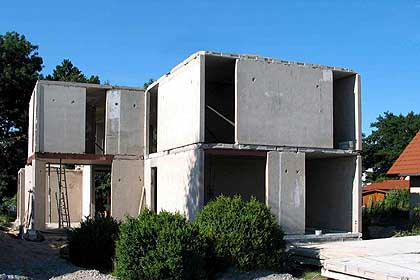Hervé Biele‘s first built project, in Mehrow, just outside Berlin, used to be a grim communist tower block in an East German housing estate.
Because of east Germany’s housing surplus, parts of the east resemble ghost towns with deserted apartment blocks, known as plattenbauen, or “slab houses”.

The plattenbauen were the GDR’s solution to its gargantuan housing problems. Made from prefabricated concrete panels, they were churned out fast and cheap in functional, almost indistinguishable designs, arranged in long, relentless blocks. When the Berlin wall came down, and the east got to see what standards in the west were like, nobody wanted to live in a plattenbau any more.
“Architecturally, the design of these 11-storey buildings was not so good,” says Dr Frank Vogdt, at the Institute for Building Rehabilitation and Modernisation. “But their technical standards are very good. It was often alleged that these buildings were badly constructed, but our institute made some tests and proved that the materials meet international standards no problem. So why not keep the technology and just change the design?”
The materials for the house in Mehrow came from an 11-storey building in Berlin’s Marzahn district.
“We don’t have to pay for the panels – they’re garbage,” explains Biele. “We just come here and say, ‘We want this one, this one and this one’; and then we cut them to shape right here and take them away to put up on site.”
Behind the site, another scarred 11-storey behemoth awaits a similar treatment. “Out of each floor, I can make one small house, so there’s 11 houses there,” says Biele. “It’s like building out of Lego.”
Via archinect Guardian.
